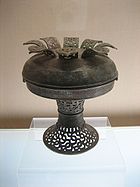
Iron Age China
Encyclopedia

Iron Age
The Iron Age is the archaeological period generally occurring after the Bronze Age, marked by the prevalent use of iron. The early period of the age is characterized by the widespread use of iron or steel. The adoption of such material coincided with other changes in society, including differing...
). Ancient China is taken to last until the beginning of Early Imperial China
Early Imperial China
Early Imperial China begins in the Iron Age with the unification of China by the Qin dynasty in 221 BC. It ended five centuries of feudal warfare, similar to that of Western Europe, that plagued the Eastern Zhou dynasty. The short-lived Qin introduced centralized government under the absolute...
and the rise of the Qin Dynasty
Qin Dynasty
The Qin Dynasty was the first imperial dynasty of China, lasting from 221 to 207 BC. The Qin state derived its name from its heartland of Qin, in modern-day Shaanxi. The strength of the Qin state was greatly increased by the legalist reforms of Shang Yang in the 4th century BC, during the Warring...
in the 3rd century BC. This corresponds to the Spring and Autumn and Warring States
Warring States Period
The Warring States Period , also known as the Era of Warring States, or the Warring Kingdoms period, covers the Iron Age period from about 475 BC to the reunification of China under the Qin Dynasty in 221 BC...
periods of Chinese history.
In 1972, near the city of Gaocheng
Gaocheng
Gaocheng is a county-level city belonging to Shijiazhuang, Hebei, China. The city has an area of 836 km² and a population of 743,000. It is located between and .-Administrative Divisions:There are 13 towns and 1 township.Towns:...
(藁城) in Shijiazhuang
Shijiazhuang
Shijiazhuang is the capital and largest city of North China's Hebei province. Administratively a prefecture-level city, it is about south of Beijing...
(now Hebei
Hebei
' is a province of the People's Republic of China in the North China region. Its one-character abbreviation is "" , named after Ji Province, a Han Dynasty province that included what is now southern Hebei...
province), an iron-bladed bronze
Bronze
Bronze is a metal alloy consisting primarily of copper, usually with tin as the main additive. It is hard and brittle, and it was particularly significant in antiquity, so much so that the Bronze Age was named after the metal...
tomahawk
Tomahawk (axe)
A tomahawk is a type of axe native to North America, traditionally resembling a hatchet with a straight shaft. The name came into the English language in the 17th century as a transliteration of the Powhatan word.Tomahawks were general purpose tools used by Native Americans and European Colonials...
(铁刃青铜钺) dating back to the 14th century BC was excavated. After a scientific examination, the iron was shown to be made from meteoric iron. The Iron Age in East Asia began in earnest, however, when cast-iron objects appeared in Yangzi Valley toward the end of the 6th century BC. The few objects were found at Changsha and Nanjing. According to the mortuary evidence suggests that the initial use of iron in Guangdong
Guangdong
Guangdong is a province on the South China Sea coast of the People's Republic of China. The province was previously often written with the alternative English name Kwangtung Province...
belongs to the mid to late Warring States period (from about 350 BC).
The techniques used in Lingnan is a combination of bivalve moulds of distinct southern tradition and the incorporation of piece mould technology from the Zhongyuan The products of the combination of these two periods are bells, vessels, weapons and ornaments and the sophisticated cast.
An Iron Age culture of the Tibetan Plateau
Tibetan Plateau
The Tibetan Plateau , also known as the Qinghai–Tibetan Plateau is a vast, elevated plateau in Central Asia covering most of the Tibet Autonomous Region and Qinghai, in addition to smaller portions of western Sichuan, southwestern Gansu, and northern Yunnan in Western China and Ladakh in...
has tentatively been associated with the Zhang Zhung culture
Zhang Zhung culture
Zhang Zhung, Shang Shung, or Tibetan Pinyin Xang Xung, was an ancient culture and kingdom of western and northwestern Tibet, which pre-dates the culture of Tibetan Buddhism in Tibet. Zhang Zhung culture is associated with the Bon religion, which in turn, has influenced the philosophies and...
described in early Tibetan writings.

